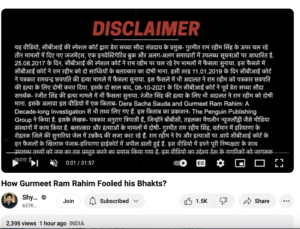
The FIRs lodged against freelance journalists Zakir Ali Tyagi and Wasim Akram Tyagi for tweeting that a scrap seller, Firoze Qureshi, was a victim of mob lynching, have confirmed fears of the new criminal laws being misused to curb free speech. They also underscore the lacunae in the new provisions on mob lynching.
On July 1, 2024, the Union government enforced the Bharatiya Nyay Sanhita (BNS), 2023, which replaced the Indian Penal Code, 1860, (along with the Bharatiya Sakshya Adhiniyam (BSA), which replaced The Indian Evidence Act, 1872 and the Bharatiya Nagarik Suraksha Sanhita (BNSS), which replaced The Code of Criminal Procedure, 1898).
Barely six days later, Zakir and Wasim were charged under Section 196 and Section 353 of the BNS with promoting enmity between different groups and causing public mischief by tweeting the allegations of Firoze Qureshi’s family members that the Muslim youth was killed by a mob in Arya Nagar locality of Jalalabad in Shamli, Uttar Pradesh.
The Shamli police have denied that the death of Firoze was due to mob lynching and said, in a statement, that the incident was being “given a communal colour” with an aim to spread ill-will. In a separate first information report, police invoked charges of culpable homicide not amounting to murder against unknown persons under Section 105 of the Bharatiya Nyaya Sanhita.
Both cases – the death of the scrap seller and the charges against the journalists – will test the new law on mob lynching as well as the grave potential to misuse provisions on promoting enmity to curb media reportage.
Tweets by Zakir Tyagi:
The application of these two Sections against the two scribes and three others, Asif Rana, Saif Allahabadi and Ahmad Raza Khan, who Zakir said, had merely copy pasted and retweeted their tweets, shows that it is business as usual. In the BNS, these sections form part of the chapter on ‘disturbing public tranquility’. Similar provisions of the erstwhile Section 153-A of the Indian Penal Code, on promoting enmity between different groups, had been used extensively against journalists, writers, academics and students and has made its reappearance in the BNS under a new guise.

On July 7, police lodged another FIR against Sadaf Kamran, a journalist who runs Hindustani Media, a popular YouTube channel. Kamran had reported on the death of Firoze Qureshi and the case lodged against the journalists.
Another journalist, Meer Faisal, received a notice to block his youtube report on the killing of Firoze Qureshi. He said:
“Days after the Uttar Pradesh Police threatened and stopped me from reporting on the alleged lynching in Shamli, the Ministry of Electronics and Information has now sent a legal notice to YouTube to block our coverage of the incident. It’s censorship and part of ongoing attacks on free press.”
“It is unclear why these FIRs are being selectively lodged against some journalists who reported on the killing when the incident was widely covered by newspapers and digital channels,” Zakir Tyagi said.
Both Zakir and Wasim Tyagi stressed that they had verified all the information they received, including copies of the FIRs lodged and video testimonies of the family of the victim, before they put out their tweets. Both journalists say they will be challenging the charges against them.
According to the complaint lodged by Afzal, Firoze Qureshi’s brother, Firoz had gone to the Arya Nagar locality on July 4 to pick up some scrap when he was beaten up by Pinky, Pankaj and Rajendra, sons of one Dharmpal, and other unnamed persons. The police eventually rescued Firoze, who was brought home in an unconscious state. He died an hour later.
Mob lynching or not?
Curiously, the Shamli police has gone to great lengths to issue statements that the case was not one of mob lynching, a provision introduced for the first time into criminal law in India in the new BNS.
Section103(2), of the Bharatiya Nyay Sanhita (BNS), 2023, reads:
When a group of five or more persons acting in concert commits murder on the ground of race, caste or community, sex, place of birth, language, personal belief or any other similar ground each member of such group shall be punished with death or with imprisonment for life, and shall also be liable to fine.
Under this section, a ‘mob’ is defined as five or more persons. In this case, the family named three persons who allegedly assaulted Firoze but the complaint clearly mentions others involved in the assault, Zakir pointed out.
However, the Shamli police has refuted the family’s claims that Firoze died due to the assault by a ‘mob’. According to a detailed report in The Wire, police said that Firoze died in his residence and the post-mortem report does not show any marks of assault. Moreover, police said that he was habituated to consuming intoxicants and a report of the analysis of his viscera is awaited.
Undoubtedly, establishing the intent of a ‘mob’ to assault and kill someone on grounds laid down under Section 103 (2) is a matter of investigation. But how adequate is the mob lynching provision, really?
As senior criminal lawyer Rebecca John said in an interview, the new statute on mob lynching does recognise it as a type of murder but it does not set out the parallel presumptions needed to establish the crime.
“If the idea of creating this provision was to highlight a terrible social phenomenon in the country, it also needs to show that five or more persons acted in concert to kill on grounds of race or caste, etc. The context of the crime needs to be given. It is not enough to put a section there and provide no parallel presumptions to aid the prosecution,” she explained, in a chat with Free Speech Collective.
“The journalists were merely carrying a message. They can’t be penalised for putting out the information of the incident and the complaint lodged,” she added.
Changing narratives
Initially, Zakir pointed out, the Additional Superintendent of Police, Shamli, Santosh Kumar Singh, was quoted in a report published by the Hindi daily Amar Ujala, saying that Firoze was beaten up by some persons and died soon after.

In the statement put out later by the Shamli police, police warn against labelling the crime as a mob lynching case:
“The deceased had entered the accused’s house drunk. Despite this, the incident was deliberately given a communal colour and it was posted on social media as mob lynching with the aim of spreading ill will. Action will be taken in the FIR registered as per the post-mortem report. Appropriate FIR has also been registered against the malicious post. The accusations are irrational and hence refuted.”
Wasim feels that the police backtracked later. “I think the police are very much under pressure. In such cases, BJP leaders and hinduvadi members gherao police and oppose the arrest of the accused,” he suggested.
“The FIR lodged against us for tweeting about the killing of Firoze Qureshi is part of this strategy to make victims the accused. We are seeing this everywhere. Whether it is the minorities, adivasis or dalits, the narrative somehow tries to blame the victims for the harm done to them,” Zakir said.
Echoing his views, Wasim adds, “this has become a pattern. Hate crimes are being normalised by labelling victims as criminals or somehow being responsible for the attack on them. In the recent incident of mob lynching in Aligarh, the deceased victim is accused of a dacoity or molestation and in this case, he is accused of some nasha (acting under the influence of an intoxicant)! This tries to cast doubts in peoples’ minds and justifies a mob crime.”
As responsible journalists, we reported the facts of the death, the testimonies of the family and the complaints lodged, Wasim said. A graduate in journalism from Makhanlal Chaturvedi National University of Journalism and Communication, Wasim is a freelance journalist, and works on special assignment with the Hyderabad-based Munsif TV. Earlier, he worked with Prabhat daily and ran ‘Nai Nasl, Nai Roshni’, an Urdu programme on All India Radio.
Zakir, who is part of the popular Youtube news channel Social Tv Hindi, has had several run ins with UP police for his social media posts. In 2017, he was barely 18 when he was charged with sedition under 124A of the Indian Penal Code and under Section 66 of The Information Technology Act, 2000 for social media posts critical of UP Chief Minister Yogi Adityanath. He spent 42 days in jail then. While sedition has been held in abeyance by the Supreme Court, Zakir says the IT act case is still pending against him.
In 2020, he was jailed for 16 days on a cow slaughter case and, in 2022, in a follow up to the 2020 case, he was externed from his home town in Meerut for six months, on grounds that his involvement in the cow slaughter case would make him a liability to the law and order situation in his village.
The cases against the journalists have drawn widespread condemnation. In a statement , DIGIPUB said that the FIRs were a “grave overreach and misuse of criminal laws” and said the journalists were doing their job and sharing information in the public interest.
In a joint statement, the Press Club of India and the Indian Women’s Press Corps said “Reporting publicly available information, irrespective of the medium of the message, qualifies as bona fide journalism. Such arbitrary application of BNS amounts to the intimidation of journalists and is a direct violation of Article 19(1)A of the Constitution.”
The case against the two journalists hinges on the police investigation of the conflicting versions of the death of Firoze Qureshi. Given the lacunae in the law on mob lynching, it is anybody’s guess as to who will win this war of narratives. Clearly, the challenge to merely report an oppositional testimony just got more precarious.


